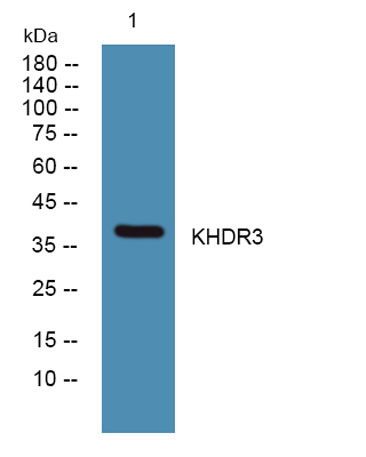






KHDR3 rabbit pAb
 One-click to copy product information
One-click to copy product information$148.00/50µL $248.00/100µL
| 50 µL | $148.00 |
| 100 µL | $248.00 |
Overview
| Product name: | KHDR3 rabbit pAb |
| Reactivity: | Human;Mouse;Rat |
| Source: | Rabbit |
| Dilutions: | WB 1:500-2000 ELISA 1:5000-20000 |
| Immunogen: | Synthesized peptide derived from part region of human protein |
| Storage: | -20°C/1 year |
| Clonality: | Polyclonal |
| Isotype: | IgG |
| Concentration: | 1 mg/ml |
| Observed Band: | 38kD |
| GeneID: | 10656 |
| Human Swiss-Prot No: | O75525 |
| Cellular localization: | Nucleus . Localized in a compartment adjacent to the nucleolus, but distinct from the peri-nucleolar one. |
| Background: | domain:The proline-rich site binds the SH3 domain of the p85 subunit of PI3-kinase.,function:RNA-binding protein that plays a role in the regulation of alternative splicing and influences mRNA splice site selection and exon inclusion. May play a role as a negative regulator of cell growth. Inhibits cell proliferation. Involved in splice site selection of vascular endothelial growth factor. Induces an increased concentration-dependent incorporation of exon in CD44 pre-mRNA by direct binding to purine-rich exonic enhancer. RNA-binding abilities are down-regulated by tyrosine kinase PTK6. Involved in post-transcriptional regulation of HIV-1 gene expression.,induction:Induced in proteinuric diseases. Down-regulated in immortalized fibroblasts isolated after a proliferative crisis accompanied with massive cell death.,PTM:Phosphorylated on tyrosine residues. Isoform 1 C-terminal region is tyrosine-rich, but isoform 2 lacking this C-terminal region is also tyrosine-phosphorylated.,similarity:Belongs to the KHDRBS family.,similarity:Contains 1 KH domain.,subcellular location:Localized in a compartment adjacent to the nucleolus, but distinct from the peri-nucleolar one.,subunit:Self-associates to form homo-oligomers. Interacts with the splicing regulatory proteins SFRS9, SAFB and YTHDC1. Interacts also with HNRPL and SLM1/KHDRBS2 (By similarity). Interacts with KHDRBS1, RBMX, RBMY1A1 and with p85 subunit of PI3-kinase. Interacts also with SIAH1 which promotes targeting for degradation.,tissue specificity:Ubiquitous with higher expression in testis, skeletal muscle and brain. Expressed in the kidney only in podocytes, the glomerular epithelial cells of the kidney. Strongly expressed after meiosis., |

 Manual
Manual